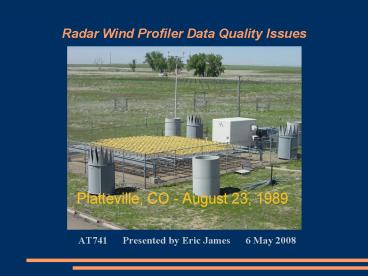Radar Wind Profiler Data Quality Issues PowerPoint PPT Presentation
1 / 12
Title: Radar Wind Profiler Data Quality Issues
1
Radar Wind Profiler Data Quality Issues
- AT741 Presented by Eric James 6 May 2008
2
Overview
- BACKGROUND
- 404 MHz Wind Profilers
- NOAA Profiler Network (NPN)
- DATA QUALITY ISSUES
- Effects of Precipitation
- Contamination by Ground Clutter
- Contamination by Gravity Waves
- Contamination by Migrating Birds
- CONCLUSIONS
3
404 MHz Wind Profilers
- Vertically-pointing radars operating at 404 MHz
frequency (74.3 cm wavelength) - 3 beams pointing upwards 1 vertically, 1 north
at 73.7 degrees elevation, and 1 east at 73.7
degrees elevation - 40 by 40 square foot, fixed, phased-array antenna
- 250 m vertical gate spacing, with measurements
from 0.5 km to 16.25 km above ground level (AGL) - Hourly wind profiles, consisting of averages of
sub-hourly (six-minute) observations - Horizontal winds are derived by
- Determining the vertical velocity from the
vertically-pointing beam - Removing the component of this along the diagonal
beams - Dividing the remaining radial velocities by the
cosine of the elevation angle (73.7 degrees)
4
The NOAA Profiler Network (NPN)
- Early profiling tests in a research environment
involved systems at 10 MHz to 10 GHz frequency - Operational network tests conducted in Colorado
in 1980s - NOAA Profiler Network (NPN) of 404 MHz profilers
established in Midwestern United States in 1992 - Key requirements for NPN
- Capability for remote, unattended operation
- Frequent (hourly) observations to supplement
radiosondes - High vertical resolution (i.e., small range gate
spacing) - Dense network of sites
- NPN data valuable in operational forecasting
environment, and for numerical weather prediction
(NWP) data assimilation
5
The NOAA Profiler Network (NPN)
- 31 densely spaced sites in Midwestern U.S.A.,
with core of network centred on Lamont, Oklahoma
(ARM) - 3 sites in Alaska, 1 in NY
- Ideal for studying synoptic and mesoscale
phenomena in Great Plains - Critical data for operational severe weather,
aviation, and winter weather forecasting
6
Effects of Precipitation
- Fundamental assumption of the profiler
observation strategy horizontal homogeneity - Horizontally homogeneous precipitation causes no
problems vertical velocity can be directly
measured (by vertical beam) and removed - Spatially varying precipitation (implying varying
fall speeds) over the distance between beams
(about 2.8 km at 10 km AGL) violates horizontal
homogeneity assumption - If taking more than one independent estimate of
horizontal winds (such as by using 5 beams
instead of 3), it is possible to flag data as
erroneous if estimates do not agree - Temporally varying precipitation requires removal
of the correct vertical velocity at each time
(for each sub-hourly observation)
7
Effects of Precipitation
- Secondary issue velocity aliasing
- Occurs when profiler maximum unambiguous velocity
is too low - Large hydrometeor fall speeds in presence of
large horizontal winds can lead to folded radial
velocities - Horizontal winds derived from folded radial
velocities will obviously be wrong - Example shows velocity folding in derived
vertical velocity near 2 km
Wuertz et al. 1988
8
Effects of Precipitation
- Yet another issue sidelobe contamination
- Figure shows ratio of precipitation reflectivity
and clear air turbulence (Bragg scattering)
reflectivity - Ratio becomes huge at high frequencies (short
wavelengths) - Precipitation within sidelobes could contaminate
main lobe observations of clear air
Balsley et al. 1982
9
Contamination by Ground Clutter
- Ground clutter is an issue for all radar systems
- Clutter contamination is reduced by the fact that
the profiler beams point at very high elevation
angles - Clutter is increased by the fact that the most
interesting data are often located in the first
several range gates, where clutter can be
appreciable - Clutter fading (due to movement of the offending
object) can cause ground clutter to have a
nonzero spectral width in profiler data,
corrupting the real Doppler spectrum
10
Contamination by Gravity Waves
- Gravity waves violate the fundamental horizontal
homogeneity assumption - Radar reflectivity directly proportional to
static stability (due to concentration or
dilution of radar scatterers) - Gravity waves produce bias in vertical motion
measurement due to inherent structure inversely
related vertical motion and static stability
(reflectivity) - In this example, vertical velocity is biased
negative in observations
Nastrom and Vanzandt 1996
11
Contamination by Migrating Birds
- Songbirds migrate between seasonal ranges in
spring and autumn, usually at night, and at low
levels (up to 4 km AGL) - Since they are large, travel in flocks, and are
full of water, they are readily detectable by
radar - Single bird in pulse volume produces trimodal
velocity spectrum peak velocity due to bird
speed, secondary peaks due to body motion during
wing flapping - Large number of birds produces high returned
power and broad Doppler velocity spectrum - Sometimes hard to detect (e.g., in LLJ)
Wilczak et al. 1995
12
Conclusions
- Profiler data useful, but significant
uncertainties and errors exist, arising from
combination of profiler measurement strategy and
certain phenomena in the atmosphere - Precipitation can violate horizontal homogeneity
assumption, produce temporally-varying vertical
velocities, cause velocity aliasing, or
contaminate clear air data by its presence in
sidelobes - Ground clutter can contaminate low-level profiler
data, particularly when clutter fading occurs - Gravity waves can violate horizontal homogeneity
assumption, and produce biases in vertical
velocity measurements due to their inherent
structure - Migrating birds can produce unrealistic wind
speeds and directions in low level profiler
observations in certain locations, in certain
seasons, and at certain times of day

